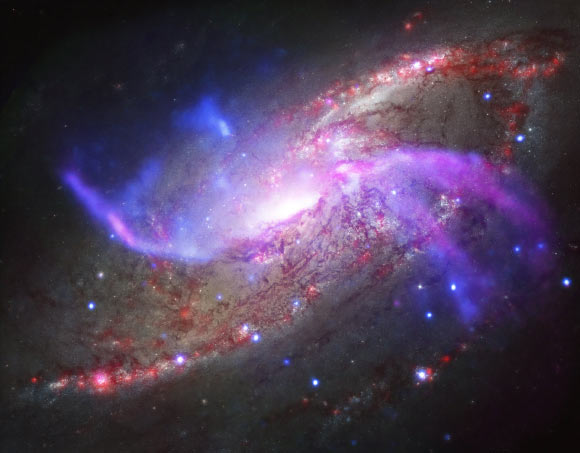Astronomers Capture Galactic Fireworks in Nearby Spiral Galaxy | Astronomy – Sci-News.com
This impressive fireworks display, which involves a supermassive black hole, enormous shock waves and vast reservoirs of gas, is taking place in an intermediate spiral galaxy called Messier 106.

This composite image shows the Milky Way-like spiral galaxy Messier 106: X-rays from NASA’s Chandra X-ray Observatory are shown in blue, radio data from the NSF’s Karl Jansky Very Large Array are shown in purple, optical data from the NASA/ESA Hubble Space Telescope are shown in yellow and infrared data from NASA’s Spitzer Space Telescope are shown in red. Image credit: NASA / CXC / Caltech / P. Ogle et al / STScI / JPL-Caltech / NSF / NRAO / VLA.
Messier 106 is located over 20 million light-years away in the small northern constellation Canes Venatici.
Also known as M106 or NGC 4258, the galaxy was discovered by Charles Messier’s observing assistant, Pierre Méchain, in 1781.
“Messier 106 is famous, however, for something that our galaxy doesn’t have — two extra spiral arms that glow in X-ray, optical and radio light,” NASA astronomers said.
“These anomalous arms are not aligned with the plane of the galaxy, but instead intersect with it.”
These extra arms are seen in the newly-released composite image of Messier 106.
Recent observations from NASA’s Spitzer Space Telescope show that shock waves are heating large amounts of gas — equivalent to about 10 million suns.
“What is generating these shock waves? We think that the supermassive black hole at the center of Messier 106 is producing powerful jets of high-energy particles,” the researchers said.
“These jets strike the disk of the galaxy and generate shock waves. These shock waves, in turn, heat the gas — composed mainly of hydrogen molecules — to thousands of degrees.”
The Chandra observations reveal huge bubbles of hot gas above and below the plane of Messier 106.
“These bubbles indicate that much of the gas that was originally in the disk of the galaxy has been heated and ejected into the outer regions by the jets from the black hole,” the scientists said.
“The ejection of gas from the disk by the jets has important implications for the fate of this galaxy.”
They estimate that all of the remaining gas will be ejected within the next 300 million years unless it is somehow replenished.
“Because most of the gas in the disk has already been ejected, less gas is available for new stars to form,” they said.
“Indeed, we used Spitzer data to estimate that stars are forming in the central regions of Messier 106, at a rate which is about 10 times less than in the Milky Way.”
Using data from ESA’s Herschel Space Observatory, the astronomers confirmed the estimate from Spitzer data of the low star formation rate in the central regions of Messier 106.
Herschel data were also used to make an independent estimate of how much gas remains in the center of the galaxy.
“After allowing for the large boost in infrared emission caused by the shock, we found that the gas mass is ten times smaller than had been previously estimated,” the researchers said.
“Because Messier 106 is relatively close to Earth, we can study how this black hole is affecting its galaxy in great detail.”
_____
P.M. Ogle et al. 2014. Jet-Shocked H2 and CO in the Anomalous Arms of Molecular Hydrogen Emission Galaxy NGC 4258. ApJL 788, L33; doi: 10.1088/2041-8205/788/2/L33
This article is based on text provided by the National Aeronautics and Space Administration.





